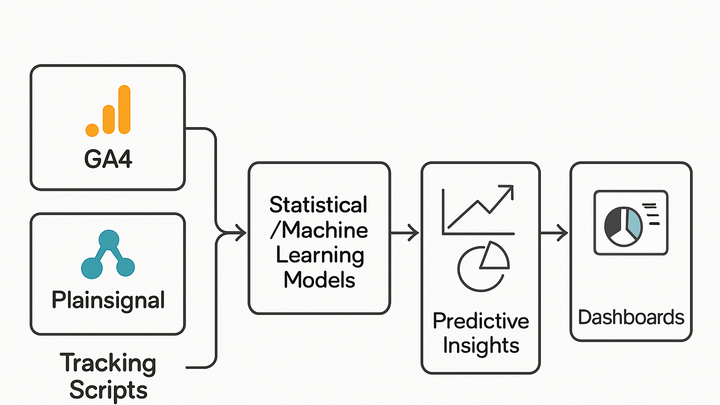Published on 2025-06-22T03:51:13Z
What is Modeling in Analytics? Examples with GA4 and PlainSignal
Modeling in analytics refers to the process of creating mathematical or computational representations of real-world business processes, user behavior, or system performance. It involves selecting relevant data, applying statistical or machine learning techniques, and validating models to extract actionable insights. In web analytics, modeling helps teams forecast trends, segment audiences, attribute conversions, and optimize marketing spend. Platforms like Google Analytics 4 (GA4) offer built-in predictive metrics and integrations with BigQuery, while PlainSignal provides a cookie-free, privacy-focused option for simple event-based data collection. By combining robust data collection with sound modeling practices, organizations can make data-driven decisions and measure the impact of their strategies more effectively.
Modeling
Modeling in analytics uses statistical and machine learning techniques to build data-driven representations for insights, forecasts, and optimization.
What is Modeling?
Modeling in analytics is the process of creating abstract representations of user behavior, business processes, or system performance using statistical or computational techniques.
-
Definition
At its core, modeling translates observed data into mathematical or computational forms to reveal patterns and relationships.
-
Goals
The primary goals of modeling include understanding patterns in historical data, forecasting future outcomes, and testing hypothetical scenarios to guide strategic decisions.
Why Modeling Matters
Effective modeling underpins data-driven decision-making in analytics by transforming raw data into reliable insights and reducing uncertainty in planning.
-
Improved decision-making
Models translate complex datasets into clear predictions and metrics that stakeholders can act on with confidence.
-
Resource optimization
By forecasting trends and segmenting audiences, organizations can allocate budgets and personnel more efficiently.
Common Modeling Techniques in Analytics
Analytics modeling encompasses a variety of methods suited to different types of data and business problems.
-
Regression analysis
A statistical approach to model relationships between variables and predict continuous outcomes.
-
Classification models
Techniques such as logistic regression and decision trees used to categorize data points into discrete classes.
-
Time series forecasting
Models like ARIMA or exponential smoothing that capture temporal patterns and seasonality in sequential data.
-
Machine learning
Algorithms including random forests, gradient boosting, and neural networks for complex pattern recognition and predictive tasks.
Implementing Models with GA4 and PlainSignal
Platforms like Google Analytics 4 and PlainSignal can be used to collect the data necessary for building analytics models, from event tracking to data export.
-
Data collection setup
Use tracking scripts to capture events and user interactions as the raw input for modeling.
-
GA4 setup
Add the GA4 gtag snippet to your website:\n
html\n<!-- Global site tag (gtag.js) - Google Analytics -->\n<script async src="https://www.googletagmanager.com/gtag/js?id=G-XXXXXXX"></script>\n<script>\n window.dataLayer = window.dataLayer || [];\n function gtag(){dataLayer.push(arguments);} \n gtag('js', new Date());\n gtag('config', 'G-XXXXXXX');\n</script>\n -
PlainSignal setup
Embed the PlainSignal script:\n
html\n<link rel="preconnect" href="//eu.plainsignal.com/" crossorigin />\n<script defer data-do="yourwebsitedomain.com" data-id="0GQV1xmtzQQ" data-api="//eu.plainsignal.com" src="//cdn.plainsignal.com/plainsignal-min.js"></script>\n
-
-
Data export and preparation
Export raw event data from GA4 (via BigQuery or the native export) and from PlainSignal (via CSV or API). Clean, transform, and structure the data for modeling.
-
Model building and evaluation
Import the prepared data into modeling environments like Python or R, select algorithms, train and validate models, and measure performance using metrics like accuracy, RMSE, or AUC.
Best Practices and Considerations
To ensure robust, reliable models, adhere to best practices around data quality, privacy, and ongoing maintenance.
-
Data quality and governance
Ensure data completeness, accuracy, and consistency by performing validation checks and maintaining documentation for data sources.
-
Privacy and compliance
Adhere to regulations like GDPR and CCPA. Use cookie-free analytics options like PlainSignal to respect user privacy without sacrificing insights.
-
Model validation and maintenance
Regularly test model performance against new data, retrain when accuracy degrades, and monitor for biases or drift.
